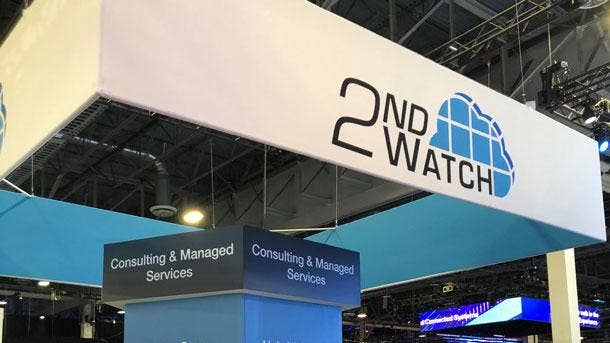2nd Watch CEO Says Company Can ‘Punch Above Our Weight’
‘We don’t wake up every morning thinking about competition — this marketplace is still more blue ocean than red ocean,’ 2nd Watch CEO Schneider tells CRN in an interview

Living and breathing the public cloud is what 2nd Watch CEO Doug Schneider believes has helped his company continue to grow after about 11 years in business, 10 as a member of the AWS Partner Network.
The Seattle-based company — a member of CRN’s Elite 150 managed service providers (MSPs) and a channel partner of AWS, Microsoft and Google Cloud, among other vendors — shows no sign of stopping, with a 40 percent growth year over year in the company’s latest fiscal quarter due to managed and professional services, more than $72 million raised in outside investment to date, 250-plus full-time employees in the U.S. and interest in making its first acquisition. The firm was also among the CRN Triple Crown award winners last year and No. 134 on the Solution Provider 500.
Schneider attributes his company’s success to specialization, a concept he advises other channel partners to think about as cloud computing adoption continues to grow.
“We don’t wake up every morning thinking about competition — this marketplace is still more blue ocean than red ocean,” Schneider told CRN in an interview. “We’re happy to compete with the bigger guys. We consistently punch above our weight. We have the benefit of being focused on one thing only — and it’s called the public cloud.”
Here’s what else the CEO had to share with CRN.

What products and services are resonating with customers lately?
Things are looking really great for us. We came off of a Q1 that was record revenues, where we’re seeing very strong growth rates in what we call managed services and also professional services.
Those grew collectively above 40 percent the past quarter. Managed services is still the larger part of our revenue, but professional services is growing at a little bit of a faster growth rate. Professional services is growing mid- to high-40 percent right now.
What we are seeing resonate with our clients are a couple things. We’ve always been out there in terms of being a pure-play cloud, public cloud solutions provider that’s really focused on delivering a world class experience to our client across a multi-cloud context, whether it’s AWS, Azure or Google, but also across a breadth and depth of services.
With companies that were born in the cloud and deliver cloud solutions, often they skew to one or the other, either just mainly a professional services shop or mainly a managed services shop. And we really built out what we consider to be a sweet spot for clients in terms of delivering value.
What’s resonating for clients too with professional services, they’re looking for a provider that they can partner with because you invest a lot of time and energy in each other, right? The clients invest time and energy and you invest time and energy in the client, and you build up a lot of contextual knowledge and relationships and the customers we’re finding want to make sure they’re leveraging that and maximizing that. That’s why they want to say, ‘Hey 2nd Watch, you know you’ve been doing AWS for me? Can you do Azure for me as well?’ Yes we can. In fact, one of our big wins this past quarter was a very large Azure managed services deal with an existing customer for whom we were doing AWS, but primarily. They’re looking for that cloud native experience with a solution provider who’s really going to pull the customer forward into the cloud native world. But they will do it in a way where the provider is just not a one-dimensional, one-trick pony. We’re able to do multiple things.

Are your clients demanding multi-cloud?
I would tell you that the bigger the customer, they seem to be the ones that are typically doing multi-cloud first. And I think it’s probably because their real estate is so large. And they’ve just got different teams of people — often large, established relationships with vendors that they want to leverage in certain ways. As you go down market and get into the middle market, we’re seeing the beginning of it more. But it’s probably going to be even a little bit more selective. It’s probably going to be more purpose driven from a capability perspective versus, often with the larger customers, it’s just driven from a vendor management perspective and risk management perspective.
What’s your customer base look like nowadays?
There are a couple ways we think about our customer base. It’s enterprises that are typically in a $200 million to $10 billion size. You can think of that as midmarket, upper-midmarket and even above. We play above that. We have very large clients that are above $10 billion as well. But typically, we’re working with clients like that because they brought us in for a very specific purpose or reason. Sometimes it’s because, ‘Hey, we have an existing managed services provider. We’re not happy. We’ve heard good things about you. Can you come in here and work with us on managing that part of the business?’ Or it’s been, ‘Hey, 2nd Watch, I’ve worked with this company over here and I’ve gone to another company that happens to be two or three times as big. But I really liked the client experience and what you guys did for us so come in over here.’ That’s often how we play in those bigger size accounts, it’s really because we are brought in for a very specific reason. We have started over the past year-plus to move into a vertical motion with some select areas. Media and entertainment for us is a very large and growing vertical. We have a lot of history there. And so now we’re working with more of the CSPs like AWS in terms of how we take their unique capabilities and dial them into a solution that’s tailored just to that vertical.
In some ways, the whole media and entertainment vertical was going through a lot of disruption and transformation for their business. So we’re front and center with a number of clients that we’ve been with for years. Over the last 12 months we’ve started to formalize a lot more. We have a solution architect specifically tied to that vertical. A sales team catering specifically to that vertical.
Hearst is a good example, a media company that has a lot of different media assets, and we’ve been helping them transform those in leveraging both Azure, AWS and Google. We have clients also that are traditional broadcast players that are evolving into digital streaming, transforming their traditional linear programming and distribution format.

Where is 2nd Watch investing its money to help grow the business?
I’ve been here for six years now as CEO. And first and foremost, we’ve always prioritized investing in our culture and our people. If you get that right, continue to do that and have a culture that’s really very focused around driving outcomes for the customers, then you know the other things with the business will take care of themselves.
In terms of other areas — years ago, a lot of our motion was around infrastructure modernization really at the IaaS (infrastructure-as-a-service) layer. And now what we’ve started to do this past 12-to-18 months and even going forward is investing in other practice areas that start to get you into the platform-as-a-service layer. Think of things like data engineering, where you’re helping clients really start modernizing their database footprint and modernize the utility that they get out of all their data.
Another area that we’re just really starting to lean into now is application modernization. Our focus isn’t so much on building the next new greenfield application. But it’s helping customers work through how they start to decompose their legacy applications and think about microservices in more containers. We see that whole area as a big growth place for us going forward as well.
And then the third one is optimization, moving from financial engineering to technical engineering and a lot of interplay with application modernization as well. We’ve managed several $100 million dollars in capacity for our clients over time. And we’ve taken that tooling we’ve developed ourselves in the analytics platform and turned that into a very robust optimization practice for us.
In the end, it’s not based on dumb luck. We’ve been at this for over 10 years. We’ve seen a lot of things and how they’ve evolved. And we keep building a terrific team. We are hiring every month.

What advice would you give smaller and newer channel partner companies?
If you think of the two bookends — generalization and specialization — you really need to lean toward the specialization bookend.
It’s gotten a lot harder to be a generalist than it was years ago when it meant that we just knew a lot within AWS. But now being a generalist means you’re across Google, AWS, Azure. Your infrastructure-as-a-service layer, your PaaS (platform-as-a-service) layer. Security.
It’s harder to be a generalist now, which means it’s also a lot more expensive. What kills a lot of companies in their early life is not understanding what to say no to. If you’re one of those earlier-stage companies, you’re probably going to have to think about being SMB (small- to -medium-sized business), down market-oriented — at least for a while.
How competitive does the landscape feel?
We don’t wake up every morning thinking about competition. This marketplace is still more blue ocean than red ocean. We have folks that we run into sometimes more often than not. But the interesting thing that we enjoy seeing is some of the competitors which were other pure-play, cloud-native startups, they’ve ended up getting acquired. We actually don’t mind seeing that because sometimes we actually viewed some of those companies as the more formidable competitors. And then they get absorbed into a very large, large enterprise and the reality is, in 12 to 18 months, things just change. They’re no longer a formidable competitor. We’re happy to compete with the bigger guys. We consistently punch above our weight. e have the benefit of being focused on one thing only — and it’s called the public cloud.

Is acquiring another company part of your growth plans?
Yeah, definitely on our mind. Historically, 2nd Watch has not done any M&A (mergers and acquisitions). But going forward, we would like to be doing some M&A — very selectively. We’re not out there trying to just buy anything. We have a defined thesis on what we’re looking for.
Would you accept more outside investment to grow?
At the end of 2019, we brought in a very large strategic investor called ST Telemedia. They’re actually out of Singapore, one of the largest sovereign wealth funds over there. And they’ve done a lot of stuff in the mobile arena, the data center arena and now we’ll call the cloud solution space. We’re fully capitalized for our organic growth trajectory. But as we do M&A, we will bring in more capital into the company. But with our new strategic investor at the table, we have the source of funds that we need.
Is international growth part of your strategy?
Yeah, it is. The beautiful thing about the public cloud — we actually have clients that we take care of internationally today, clients that we’ve serviced their needs across France and Brazil and China. We’ve sent people to Australia, New Zealand. We cater to clients today that have global operations. Telemedia has another couple of companies that they own that are like a 2nd Watch in certain ways that are based over in Asia Pacific.

What investments can your vendor partners make that would help with your business?
What I would want to see is — and we’re starting to lean into them more — collaborating. Collaborating around a vertical market, being more selective with the partners that are investing and showing up with resources and people and customers that go in that vertical. I would say do it in a way where you’re also holding up the cloud-native, pure-play solution providers — not just the existing legacy providers out there, because I’ve always believed that we’d come with a different value proposition. We’re able to put the client’s self-interest first consistently because we’re not hanging on to any kind of legacy.
We were fortunate that we were one of the first Premier partners around the table with AWS back in 2011. We were able to really ride that wave effectively because we really became great at delivering outcomes and a client experience that was very aligned with AWS. Now, there’s so many partners out there.